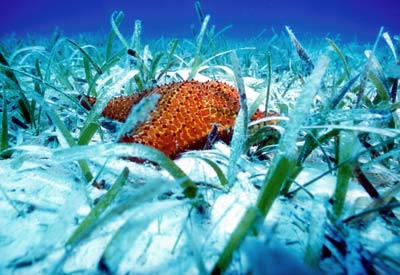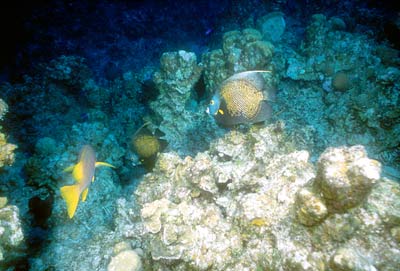Ecology, Conservation and Extinction
Ecology, Conservation and Extinction
BY THOMAS R. SAWICKI
The one process ongoing in the 1980s that will take millions of years to correct is the loss of genetic and species diversity by the destruction of natural habitats. This is the folly that our descendants are least likely to forgive us.
E. O. Wilson, 1985
 |
|
Photo by David
Rhea
|
Since life first appeared on Earth some 3.8 billion years ago, it has been estimated that more than 99.9% of all species have gone extinct (Raup, 1991a). Today, all the extant (living) species on Earth may represent less than one-tenth of 1% of all the species that have ever existed. Billions of species have gone extinct throughout geologic history. Many of these went extinct during mass extinction events, the most famous and well documented of which took place some sixty-four million years ago at the end of the Mesozoic Era. This mass extinction event marked the end of the reign of dinosaurs. Many conservationists worry that we have entered another time of mass extinction, this one not caused by meteorites, comets, massive climate change or other such natural processes, but by human beings. But why do conservationists and ecologists believe this? How does the current rate of extinction compare to the historical average? Lastly, if we have entered a human-induced mass extinction event, why should we care?
Estimates of the numbers of extant species vary and are based primarily on sampling efforts from various habitats, especially tropical rain forests. The eminent Harvard entomologist Edward O. Wilson (1992) estimated that the number of described species, i.e., species known to and named by science, is approximately 1.4 million. Wilson (1992) and Erwin (1982) have estimated that the number of extant species of insects alone could actually be from 10-30 million. We simply don't know how many species there are, but we do know that the number is orders of magnitude greater than what have been described. Determining the current rate of extinction involves calculations based on the landmark work on island biogeography by Robert MacArthur and E. O. Wilson in 1967. They demonstrated that all else being equal, there is a strong relationship between the island's size and the numbers of species that will inhabit the island (Fig. 1).
[Download PDF figures for this article]
The relationship demonstrated in Figure 1 is described by the equation S = cAz, where S is the number of species, A is the area being studied and c is a constant that is dependent upon the type of organism being studied (that is, you would expect more insects than mammals in a given area). The exponent z is also a constant that determines how strong the effect of island size is on the number of species. This number generally runs from .2 to .35, although it can be greater. Figure 2 clearly shows this relationship. Within that range of z values, a 90% loss in habitat results in a loss of 37.5% to 55% of the species. These data are derived from measuring island areas and then counting the number of species found on islands of different sizes. This same approach can be used to determine the number of species in "island patches" such as areas of rain forests or coral reefs (Wilson, 1989).
The relationship between area and biodiversity, derived from basic research on island biogeography, allows us to estimate the extinction rates for species not yet described. It is important to note that these estimates may be very conservative. Why? One reason is that if the remaining habitat is fragmented, a more extreme "islanding effect" may occur. Another is if the species in the remaining habitat are highly endemic--found nowhere else--the number of species facing extinction obviously would be higher. In fact, it can be so high that the percentage of species lost may equal the percentage of area lost (Meffe and Carroll, 1997).
 |
|
Photo by David
Rhea
|
The area of tropical rain forest being destroyed is easily calculated through remote sensing technology such as satellite imagery. Wilson (1992) determined that given the current 2% annual loss in tropical rain forest habitat due to deforestation, and an estimated five million rain forest species, between 20,000 and 30,000 species are going extinct each year. But how do these numbers compare to what we should expect as a natural background rate of extinction? After all, most species that have ever lived have gone extinct, so shouldn't we expect such high numbers? We can calculate this by knowing how long the average species exists, something paleontologists determined by examining fossil records. Most species live roughly four million years before going extinct. So about one species out of four million will go extinct every year. If there is a total of 40 million species on Earth today (a relatively high estimate) then 10 species should be going extinct EACH YEAR (Raup, 1991a). With the current and conservative estimate of 20,000-30,000 species going extinct annually, we have up to 80 species going extinct EACH DAY (Wilson, 1992)!
Coral reefs cover approximately 600,000 km2 or about 0.2% of the ocean's surface. However, these ecosystems may account for a third of the ocean's fish species (Meffe and Carroll, 1997). Coral reefs may have even higher biodiversity than tropical rain forest systems, but it has been estimated that within 20-40 years 60% of coral reefs may be destroyed. Current estimates suggest that 5-10% of coral reefs have been destroyed and up to 93% have been damaged by human activities (Dubinsky, 1990; Reaka-Kudla et al., 1996). In light of these stark facts, it is not hard to see the potential magnitude of loss from such destruction.
"So what?" one might ask. There are several different ways to respond to this question. First, many of the medicines we use today are derived from chemicals produced by both plants and animals. Today, science has examined and tested the chemical potency of only a small fraction of the organisms that are known to it, let alone the vast numbers that are unknown to it. Each day we may be losing organisms that could provide us with breakthroughs in fighting disease and in developing natural pesticides, organisms that could potentially help us to address both current and future needs. Second, it is important to remember that species do not exist in a vacuum; they are linked together through communities and ecosystems. Thus, the loss of one species can affect others. For instance, over-fishing on a coral reef can result in a decrease of coral species, as filamentous and calcareous algae overgrow the reef (Mann, 2000). Third, human beings have evolved with the biosphere. Altering ecosystems and destroying the species that exist within them may result in the eventual collapse of the entire system, upon which human life depends. If we remove enough key components from life's structure, we may unwittingly alter our biosphere enough to cause our own extinction.
Loss of species diversity is actually much more complex than simply the loss of habitat area. Dynamiting and harvesting coral reefs for building material or slash and burn agriculture are obvious threats, but less obvious threats can be just as deleterious. For instance, the over-harvesting of fish or other species for food, increased nutrient load due to pollution, increased sedimentation due to the loss of mangrove forests and the introduction of non-native species, to name a few, all pose serious threats to the health of coral reefs. Habitat loss can provide us with a convenient means of estimating extinction, but as with most phenomena in the natural world, the situation is much more complicated. Thus, the already large estimates of extinction rates may be too low. It is clear, however, that there is a link between area and biodiversity. By supporting the preservation of natural areas, we can have an impact on the preservation of species. It is a daunting challenge that we, as a species, face, one that requires that we first understand the magnitude of the problem.
- Sources and Further Reading
Dubinsky, Z. (ed.). 1990. Coral Reefs. Ecosystems of the World, Vol. 25. Elsevier, Amsterdam. - Erwin, T. 1982. Tropical Forests: Their Richness in Coleoptera and Other Arthropod Species. Coleoptera Bulletin 36:74-82.
- Meffe, G. K. and C. R. Carroll. 1997. Principles of Conservation Biology. Sinauer Associates, Inc. Sunderland, MA.
- MacArthur, R. H. and E. O. Wilson. 1967. The Theory of Island Biogeography. Princeton University Press, Princeton, N.J.
- Mann, K. H. 2000. Ecology of Coastal Waters With Implications for Management. Blackwell Science, Malden, MA.
- Raup, D. M. 1991a. Extinction: Bad Genes or Bad Luck? W. W. Norton, New York.
- Reaka-Kudla, M. L. 1997. The Global Biodiversity of Coral Reefs: A Comparison with Rain Forests. In Reaka-Kudla, M. L., D. W.
- Wilson and E. O. Wilson, (eds.). Biodiversity II: Understanding and Protecting our Natural Resources, pp. 83-108. National Academy Press, Washington, D. C.
- Wilson, E. O. 1985a. The Biological Diversity Crises. Bioscience 35:700-706.
- Wilson, E. O. 1989. Threats to Biodiversity. Scientific American. 261:108-117.
- Wilson, E. O. 1992. The Diversity of Life. Belknap Press of Harvard University Press, Cambridge, MA.
Thomas R. Sawicki is a graduate student at Old Dominion University where he is working on a Ph.D. in Ecological Sciences.Ê He is currently investigating the phylogeny of the troglobitic amphipod family Hadziidae. His research has brought him to study and dive caves throughout the Caribbean and southern Atlantic.

